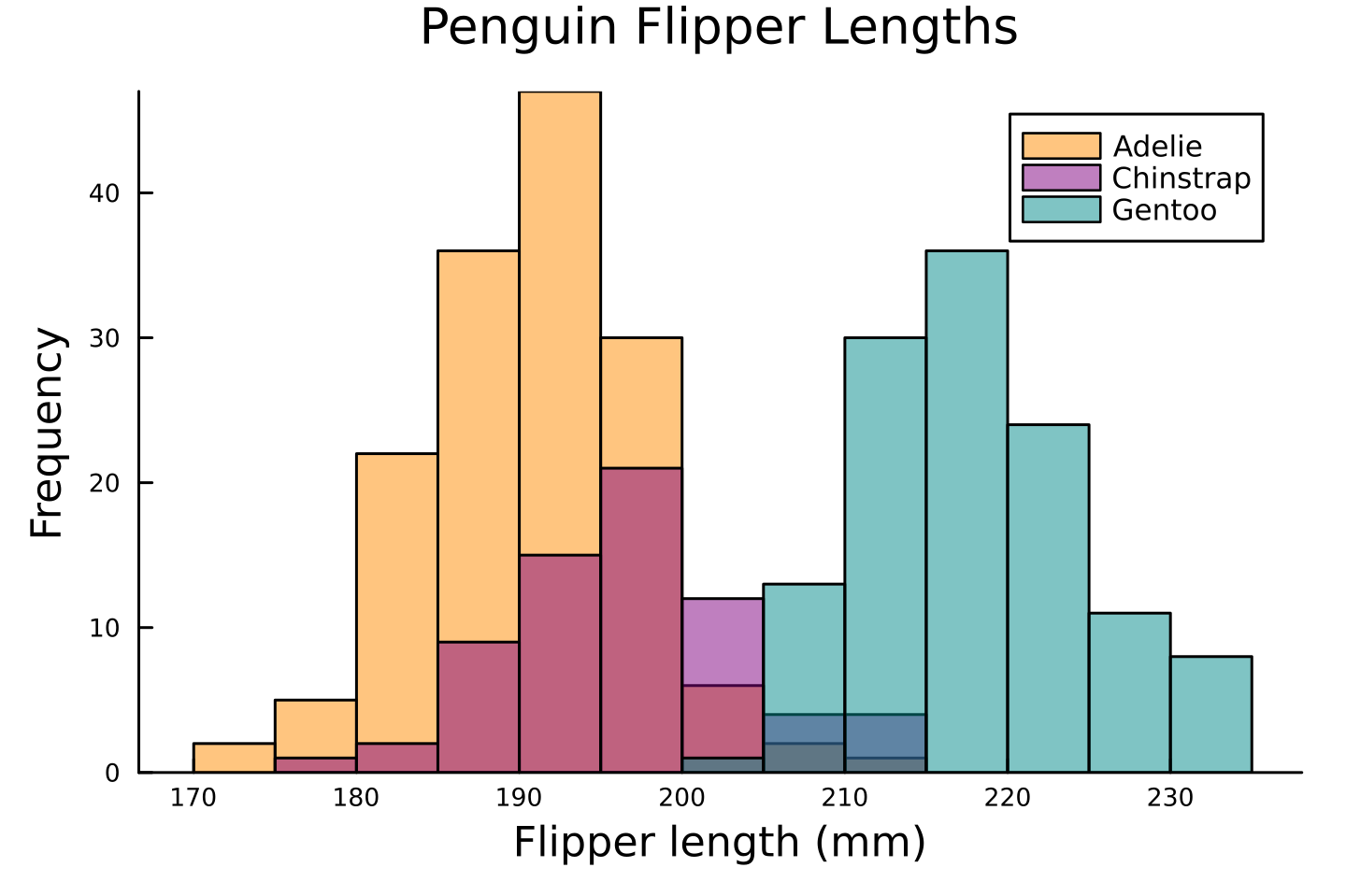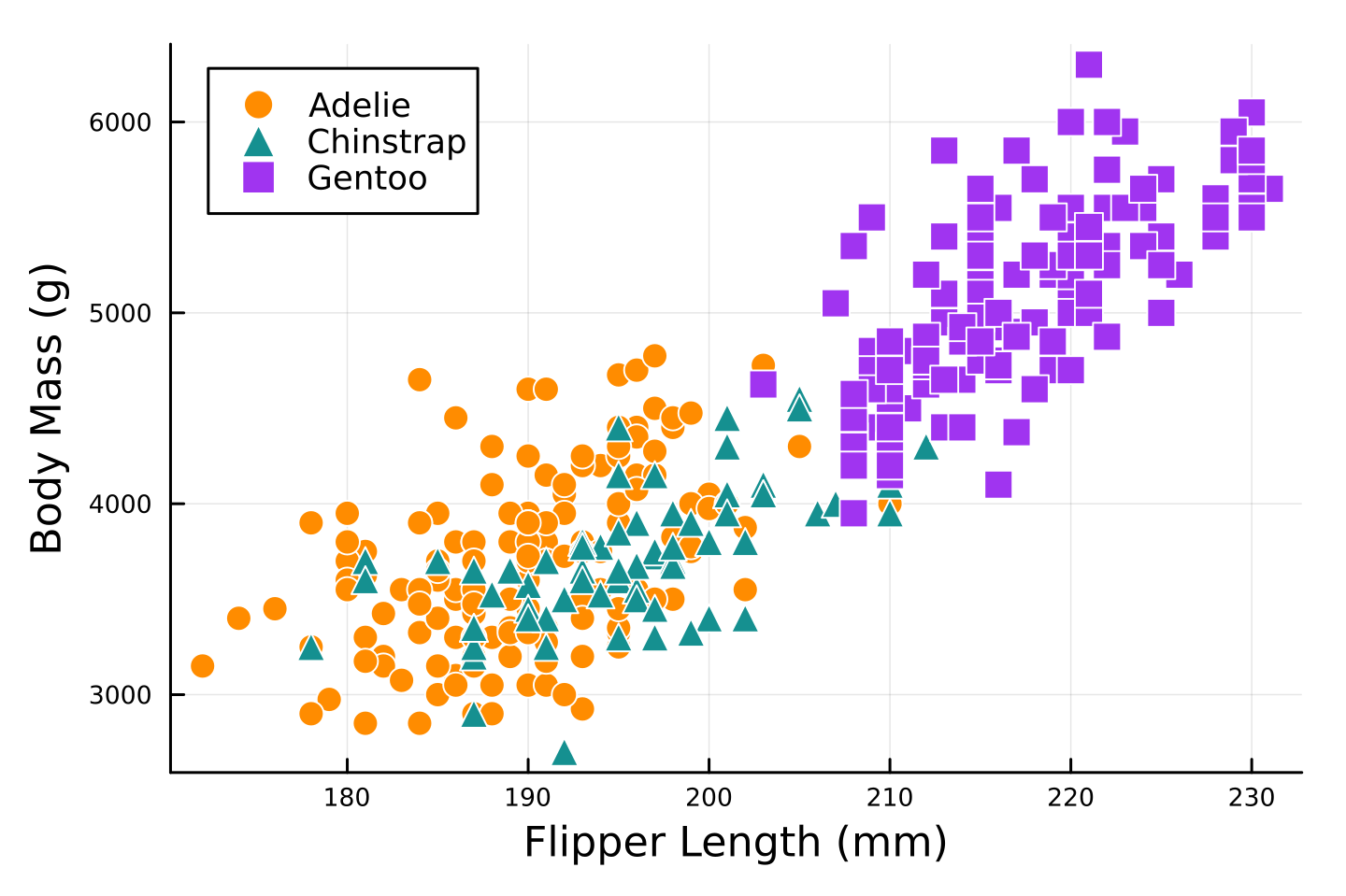---
title: "Quarto Is Multi-lingual!"
date: 2023-4-30
author: Kazuharu Yanagimoto
categories: [Julia, Python, R, Quarto, Stata]
image: img/matthias-heyde-8HLMLrkyLvE-unsplash.jpg
twitter-card:
image: img/matthias-heyde-8HLMLrkyLvE-unsplash.jpg
knitr: true
execute:
warning: false
message: false
---
A common misunderstanding about Quarto is that we cannot use multiple languages
within a document.
Indeed, _Jupyter_ cannot use multiple languages within a document,
and we usually use the jupyter engine for Python and Julia (and it is officially supported.)
However, _knitr_ has already been able to execute multiple languages tons of years ago,
so why can't we do it in Quarto?
Let's see the following example with `palmerpenguins::penguins` of @horst2020
### R
```{r}
#| fig-width: 6
#| fig-height: 4
#| fig-align: center
library(palmerpenguins)
library(ggplot2)
ggplot(data = penguins, aes(x = flipper_length_mm)) +
geom_histogram(aes(fill = species),
alpha = 0.5,
position = "identity") +
scale_fill_manual(values = c("darkorange","purple","cyan4")) +
labs(x = "Flipper length (mm)",
y = "Frequency",
title = "Penguin Flipper Lengths",
fill = NULL) +
theme_minimal() +
theme(panel.grid.major.x = element_blank(),
panel.grid.minor = element_blank(),
legend.position = c(0.9, 0.9))
```
### Python
To run a python code on _knitr_, `install.packages("reticulate")`
```{python}
#| fig-width: 6
#| fig-height: 4
#| fig-align: center
from palmerpenguins import load_penguins
import seaborn as sns
import matplotlib.pyplot as plt
penguins = load_penguins()
plt.clf()
sns.histplot(data=penguins, x='flipper_length_mm',
hue='species', palette=['#FF8C00', '#159090', '#A034F0'])
plt.xlabel("Flipper length (mm)")
plt.ylabel("Frequncy")
plt.legend(title = "")
plt.show()
```
### Julia
To run a julia code on _knitr_, run `install.packages("JuliaCall")`.
`PalmerPenguins.load()` asks you to download the data,
so you have to set `ENV["DATADEPS_ALWAYS_ACCEPT"] = true` to automatically accept it.
```{julia}
#| fig-width: 6
#| fig-height: 4
#| fig-align: center
using PalmerPenguins
using StatsPlots
using DataFrames
ENV["DATADEPS_ALWAYS_ACCEPT"] = true;
penguins = DataFrame(PalmerPenguins.load());
histogram(
[penguins[penguins.species .== species, :].flipper_length_mm for species in ["Adelie", "Chinstrap", "Gentoo"]],
label = ["Adelie" "Chinstrap" "Gentoo"],
fillcolor = [:darkorange :purple :cyan4],
fillalpha = 0.5,
xlabel = "Flipper length (mm)",
ylabel = "Frequency",
title = "Penguin Flipper Lengths",
legend = :topright,
grid = false,
legendfontsize = 7,
legendtitle = nothing,
bar_width = 5,
size = (480, 320),
dpi = 300,
tickfontsize = 6,
guidefontsize = 10,
titlefontsize = 12,
margin=Plots.Measures.Length(:mm, 2.0)
)
```
### Stata
Douglas Hemken's [Statamarkdown](https://github.com/hemken/Statamarkdown)
allows us to use Stata on Rmarkdown (so as on Quarto!)
```{r, filename = "R"}
# devtools::install_github("Hemken/Statamarkdown")
library(Statamarkdown)
haven::write_dta(penguins, here::here("blog/2023/04/30/quarto_multi_lang/palmerpenguins.dta"))
```
Thanks to `Statamarkdown`, we can easily set the working directory to the directory where the `.qmd` file exists by just calling `cd` in Stata.
```{stata, filename = "Stata"}
cd
```
Then, you can run Stata code in a code chunk.
```{stata, results="hide"}
use palmerpenguins.dta, clear
twoway (hist body_mass_g if species == 1, color(orange%40)) ///
(hist body_mass_g if species == 2, color(emerald%40)) ///
(hist body_mass_g if species == 3, color(purple%40)), ///
xtitle("Body Mass (g)") ytitle("Frequency") ///
legend(order(1 "Adelie" 2 "Chinstrap" 3 "Gentoo") pos(1) ring(0) col(1)) ///
plotregion(fcolor(white)) graphregion(fcolor(white))
graph export "figure/stata/hist.svg", replace
```

But you have to manually export an image file for a plot and add it into a document...
## Tabset
I think, one of the most useful case is when you want to support multiple source codes
in a textbook or lecture notes.
Quarto supports [Tabset layout](https://quarto.org/docs/interactive/layout.html#tabset-panel)
and it's so smart!
::: {.panel-tabset}
## R
```{r}
#| fig-width: 6
#| fig-height: 4
#| fig-align: center
penguins |>
ggplot(aes(x = flipper_length_mm, y = body_mass_g,
color = species, shape = species)) +
geom_point(size = 3) +
scale_color_manual(values = c("darkorange","purple","cyan4")) +
labs(x = "Flipper Length (mm)", y = "Body Mass (g)", color = NULL, shape = NULL) +
theme_minimal() +
theme(legend.position = c(0.9, 0.1),
panel.grid.major = element_blank())
```
## Python
```{python}
#| fig-width: 6
#| fig-height: 4
#| fig-align: center
plt.clf()
sns.scatterplot(data=penguins, x='flipper_length_mm', y='body_mass_g',
hue='species', style="species",
palette=['#FF8C00', '#159090', '#A034F0'])
plt.xlabel('Flipper Length (mm)')
plt.ylabel('Body Mass (g)')
plt.legend(title = "")
plt.show()
```
## Julia
```{julia}
@df penguins scatter(
:flipper_length_mm,
:body_mass_g,
group = :species,
markersize = 5,
markershape = [:circle :utriangle :rect ],
markerstrokecolor = :white,
palette = ["#FF8C00", "#159090", "#A034F0"],
xaxis = "Flipper Length (mm)",
yaxis = "Body Mass (g)",
size = (480, 320),
dpi = 300,
legendfontsize = 8,
tickfontsize = 6,
guidefontsize = 10,
margin=Plots.Measures.Length(:mm, 2.0)
)
```
## Stata
```{stata, results="hide"}
use data/palmerpenguins, clear
separate body_mass_g, by(species)
twoway scatter body_mass_g? flipper_length_mm, ///
mcolor(orange emerald purple) mlab("") ///
msymbol(O T S) ///
xtitle("Flipper Length (mm)") ytitle("Body Mass (g)") ///
legend(order(1 "Adelie" 2 "Chinstrap" 3 "Gentoo") pos(11) ring(0) col(1)) ///
plotregion(fcolor(white)) graphregion(fcolor(white))
qui graph export "figure/stata/scatter.svg", replace
```
`
{fig-align=center}
:::
Have a happy Quarto life 🥂!





